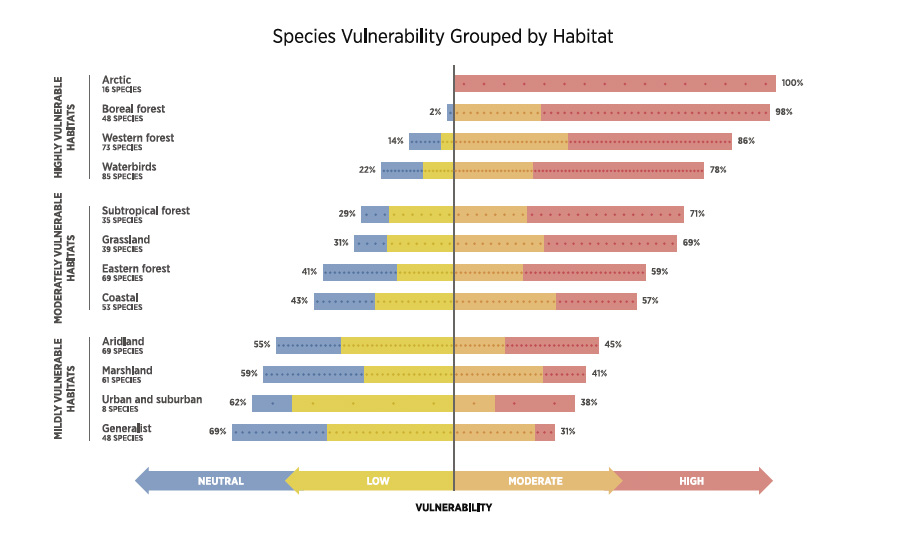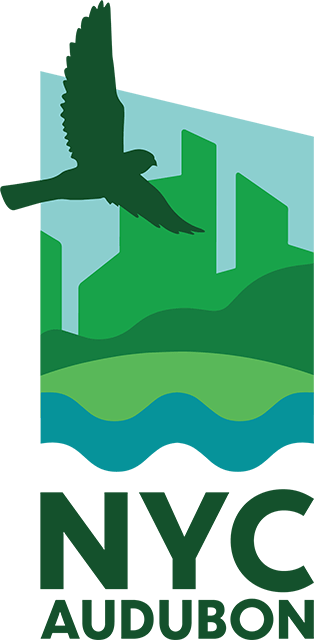Birds and Climate Change
An iconic bird of eastern woodlands, the musical Wood Thrush is enormously helped if we reduce carbon emissions: It could lose 60 percent of its current range, forced north into what is now boreal forest, if global temperatures rise 3.0 degrees, but mostly stays put after 1.5 degrees. Source: Survival by Degrees: 389 Bird Species on the Brink, by National Audubon. Data visualizations and design: Stamen Design
The most critical threat to birds and our planet at large, Climate Change affects all habitats in different ways. Rising sea levels are particularly ominous for coastal communities of both birds and people, but many non-coastal bird species may also be adversely affected by rising temperatures. According to National Audubon’s climate report, Survival by Degrees: 389 Bird Species on the Brink, two-thirds of North American birds are at increasing risk of extinction from global temperature rise.
As temperatures rise and affect our ecosystem in countless ways, the habitats upon which birds depend are also changing. Plant or animal species that are critical to bird species’ survival may decline. Certain habitats may vanish entirely. Some bird species may be able to adapt to these changes; others may not.
 "}" data-trix-content-type="undefined" class="attachment attachment--content">
"}" data-trix-content-type="undefined" class="attachment attachment--content">Climate-Threatened Birds Are New York City’s Birds
Many of the bird species in the habitat groups most vulnerable to climate change are frequent visitors or residents in New York City. “Arctic” species include winter visitors to our area such as Long-tailed Duck, Snow Bunting, and American Tree Sparrow. “Waterbirds” and “Coastal” species include many species of waterfowl and shorebirds that migrate through and breed in the City, as well as the egrets and herons that nest on the Harbor Heron Islands. Species of the “Boreal Forest,” “Eastern Forest,” and “Grasslands” include most of the songbirds that pass through and breed in New York City, such as the Blackburnian Warbler, Wood Thrush, and Grasshopper Sparrow.
NYC Audubon conservation programs protect and support many climate-vulnerable bird species. By reducing bird deaths from window collisions and conserving and enriching bird habitat, we may help bird populations be more resilient in the face of shifting and declining habitats over the coming decades. By supporting the conservation and creation of new green spaces in the City, including green roofs, we may reduce energy consumption and fossil fuel use by mitigating the “heat island effect” in the City. And the preservation of coastal habitats, and advocacy in favor of sustainable and environmentally friendly climate resiliency measures, will protect low-lying communities from flooding and storm surges, in addition to protecting coast birds species.
Learn more about National Audubon’s research on birds and climate change, and about Audubon’s climate initiative.
Audubon’s Survival by Degrees report found that 64 percent of North American bird species (389 of 604 species studied) are moderately or highly vulnerable to climate change across both breeding and non-breeding seasons. However, as shown in the chart above, climate change vulnerability was not evenly distributed across habitats. Across seasons and scenarios, Arctic bird species were found to be the most vulnerable; 100 percent are considered highly vulnerable. Other highly vulnerable habitat groups include boreal forest birds (98 percent highly vulnerable), western forest birds (86 percent), and waterbirds (78 percent). Habitat groups with intermediate vulnerability included subtropical forests (71 percent), grasslands (69 percent), eastern forests (59 percent), and coastal areas (57 percent). Even in the remaining low-vulnerability groups, more than a quarter of the species were considered climate-vulnerable.
Audubon’s Survival by Degrees report found that 64 percent of North American bird species (389 of 604 species studied) are moderately or highly vulnerable to climate change across both breeding and non-breeding seasons. However, as shown in the chart above, climate change vulnerability was not evenly distributed across habitats. Across seasons and scenarios, Arctic bird species were found to be the most vulnerable; 100 percent are considered highly vulnerable. Other highly vulnerable habitat groups include boreal forest birds (98 percent highly vulnerable), western forest birds (86 percent), and waterbirds (78 percent). Habitat groups with intermediate vulnerability included subtropical forests (71 percent), grasslands (69 percent), eastern forests (59 percent), and coastal areas (57 percent). Even in the remaining low-vulnerability groups, more than a quarter of the species were considered climate-vulnerable.



